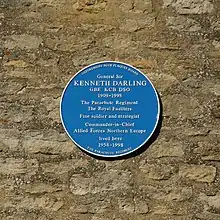Kenneth Darling
General Sir Kenneth Thomas Darling GBE, KCB, DSO (17 September 1909 – 31 October 1998) was a senior British Army officer who after serving with distinction during the Second World War was Commander-in-Chief (C-in-C) of Allied Forces Northern Europe 1967–69.
Sir Kenneth Darling | |
|---|---|
.jpg.webp) General Sir Kenneth Darling (centre) in 1968. | |
| Born | 17 September 1909 Bengal Presidency, British India |
| Died | 31 October 1998 (aged 89) Chesterton, Oxfordshire, England |
| Allegiance | |
| Service/ | |
| Years of service | 1929–1969 |
| Rank | General |
| Service number | 44052 |
| Unit | Royal Fusiliers Parachute Regiment |
| Commands held | 11th Battalion, Royal Fusiliers 12th (Yorkshire) Parachute Battalion 5th Parachute Brigade 16th Parachute Brigade II Corps 1st (British) Corps Southern Command Allied Forces Northern Europe |
| Battles/wars | World War II Palestine Emergency Cyprus Emergency |
| Awards | Knight Grand Cross of the Order of the British Empire Knight Commander of the Order of the Bath Distinguished Service Order |
| Relations | Douglas Darling (brother) |
Early life
Darling was born in British India,[1] the eldest son of George Kenneth Darling (1879–1964) of the Indian Civil Service and his wife Mabel Eleanor, née Burgess (d. 1952). His younger brother, the future Major General Douglas Darling (1914–1978), was also to become a distinguished soldier.
Military career
Upon being sent to England, Kenneth Darling was educated at Eton College and the Royal Military College, Sandhurst, where he was commissioned as a second lieutenant into the Royal Fusiliers on 29 August 1929.[2][1] He served with the 2nd Battalion of his regiment, in the United Kingdom, before serving with the 1st Battalion in India for eight years, from 1930 to 1938.[3] He was promoted to lieutenant on 29 August 1932,[4] and captain on 1 August 1938.[5]
Soon after the outbreak of World War II in September 1939 Darling returned to the United Kingdom where, from January−April 1940 he attended the Staff College, Camberley as a student, and after graduating he was made a brigade major with the 1st London Brigade, part of the 1st London Division. Serving briefly as a General Staff Officer Grade 2 (GSO2) at the War Office, he was an instructor at the Senior Officers' School, Wiltshire, from January−October 1941, before returning to the War Office for eight months as GSO1 Military Training. From June 1942 he was Commanding Officer (CO) of the 11th Battalion, Royal Fusiliers. He commanded the battalion, a second line Territorial Army which formed part of the 140th Brigade, itself part of the 47th (London) Infantry Division.[3][6]
He served in North West Europe during 1944 and 1945 and was awarded the Distinguished Service Order on 7 June 1945 while serving with the 12th (Yorkshire) Parachute Battalion, initially as its second-in-command and then as its commanding officer.[7][3][8]
He became Commander of the 5th Parachute Brigade in 1946, then serving in Palestine during the Palestine Emergency, of the Airborne Forces Depot in 1948 and of the 16th Independent Parachute Brigade in 1950.[1][9]
He was Chief of Staff of I (British) Corps from 1955, General Officer Commanding II Corps from 1956 and then Deputy Director, Staff Duties at the War Office from 1957.[1] He went on to be General Officer Commanding and Director of Operations Cyprus District in 1958,[10] Director of Infantry in 1960 and General Officer Commanding I (British) Corps in 1962.[1] His last appointments were as General Officer Commanding-in-Chief at Southern Command in 1964 and Commander in Chief of Allied Forces Northern Europe from 1967 until his retirement in 1969.[1]
Darling was appointed a Knight Grand Cross of the Order of the British Empire in 1969, Knight Commander of the Order of the Bath in 1963, Commander of the Order of the British Empire in 1957 and Companion of the Order of the Bath in 1957. He was Honorary Colonel of the Royal Fusiliers (City of London Regiment) from 1963 to 1968,[11] Colonel Commandant of the Parachute Regiment from 1965 to 1967, Honorary Colonel of the Royal Regiment of Fusiliers from 1968 to 1974 and ADC General to the Queen during 1968 and 1969.

In 1941 Darling married Pamela Denison-Pender (1915–). His wife's sister, Cynthia, was married to the soldier and racing correspondent Roger Mortimer.
Darling lived at Vicarage Farmhouse, Chesterton, Oxfordshire from 1958 until his death on 31 October 1998. An Oxfordshire Blue Plaque commemorating him was unveiled on his house on 4 July 2015.[12]
References
- Arthur, Max (12 November 1998). "Obituary: General Sir Kenneth Darling". The Independent. London. Retrieved 28 August 2009.
- "No. 33530". The London Gazette. 30 August 1929. p. 5645.
- "Private papers of General Sir Kenneth Darling GBE KCB DSO". Imperial War Museum.
- "No. 33859". The London Gazette. 30 August 1932. p. 5562.
- "No. 33538". The London Gazette (Supplement). 5 August 1938. p. 5031.
- "Kenneth T Darling | ParaData".
- "No. 37112". The London Gazette (Supplement). 5 June 1945. p. 2877.
- "Kenneth T Darling | ParaData".
- "Kenneth T Darling | ParaData".
- "CYPRUS: In the Front Line". Time. 24 November 1958. Archived from the original on 18 October 2007. Retrieved 28 August 2009.
- "Royal Fusiliers colonels". British Empire. Retrieved 23 January 2016.
- "General Sir Kenneth Darling (1909–1998)". Oxfordshire Blue Plaques Board. Retrieved 23 January 2016.
Sources
- Who Was Who. Vol. X, 1996–2000. London. 2001. ISBN 0-7136-5439-2.
{{cite book}}: CS1 maint: location missing publisher (link) - Norton, GG (1973). The Red Devils. Leo Cooper Famous Regiment Series. London: Macmillan. ISBN 978-0330236317.